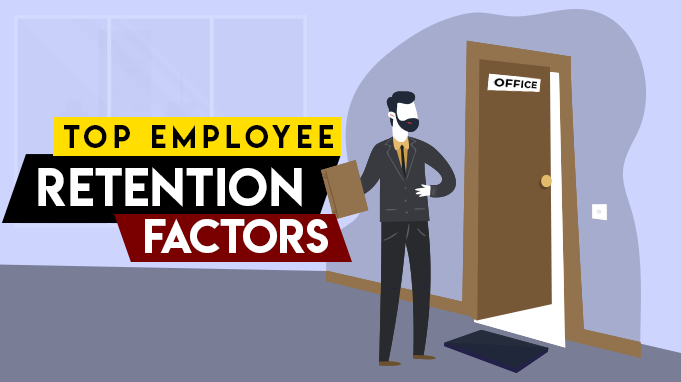8 Top Employee Retention Factors

Employee retention refers to the ability of an organization to retain its employees.
Good organizations hire the best talents and know how to retain them for a more extended period. Employees are the lifeline of any organization. When these skilled employees walk out of the door, it becomes challenging to find suitable replacements.
High turnover not only affects an organization’s bottom line but also is a costly process. And it is often more challenging to train new employees. Studies say that for a new employee to fully adapt to a new organization, it takes more than eight months of onboarding and sometimes even more.
Even with reasonable compensation and benefits, employees quit. The reason for this varies with many factors.
Here in this blog, I am going to talk about the top 8 employee retention factors. Before I start, let’s look into the following employee retention statistics.
83 % of employers believe attracting and retaining talent is a growing challenge. (Allegis Group)
66 % of millennials expect to leave their organization by 2020. (Glassdoor)
The top reasons given by employees for leaving their jobs include
- lack of career development (22%),
- lack of support with work-life balance (12%),
- their manager’s behavior (11%),
- unsatisfactory compensation and benefits (9%),
- and poor wellbeing (9%). (Work Institute)
Among HR professionals who claim difficulty in retaining older workers,
- 47 % cite work location inflexibility as the biggest challenge,
- career inflexibility (45%),
- and work hours inflexibility (44%). (SHRM)
78 % of employees said they would remain longer with their employer if they saw a career path within the current organization. (Mercer)

Employee Retention Factor #1: Employee Morale
In Human Resources, employee morale is defined as job satisfaction, outlook, and wellbeing, and employee experiences in a workplace.
According to Dalton E. McFarland, morale is a group phenomenon. It is a concept that describes the level of the favorable or unfavorable attitude of employees on their work, the company, their tasks, work environment, fellow workers, and superiors.
Employees are happy and more productive when employee morale is high. Likewise, low employee morale results in less productivity and low spirits. Low employee morale is one of the significant factors why an employee leaves an organization.
Employees don’t just quit their jobs. They do it when they are not happy with the organization’s work culture they work for.
Employee Retention Factor #2: Lack of Career Development
Often employees are not content with their career path. Lack of proper training and development programs hinders their career growth. Their skills become limited with time, and they lose interest in what they do.
Every employee has his/her talents. It is an organization’s responsibility to show them the path to use these skills and give their career a direction. Every employee wants to excel in what they do and grows in the process. They need to know where their job is heading. A sense of security is a must for every employee. Nobody wants to ride a boat without a rudder.
Organizations often miss out on understanding this human perspective of their employees. The same monotonous work profile or assigned tasks makes the employees vulnerable at times. Eventually, they leave their organizations for better career growth and prospects.
Employee Retention Factor #3: Poor Employee Manager Relationship
The employee-manager relationship is crucial. Employees crave good relationships at work. Managers need to form an interpersonal connection with their employees. For most employees, a good salary and benefits may not keep them engaged and happy if they can’t tolerate their managers.
When managers lack good management skills, they fail to form a good work relationship with employees. This eventually leads to high employee turnover and the bottom line.
Employee Retention Factor #4: Lack of Recognition
Effective leadership involves reinforcing and motivating employees to bring out the best in them.
Society for Human Resource Management reported that the most essential workplace challenge is employee turnover and retention.
Also, in the same survey report, 71% of respondents believed employee recognition programs increased retention.
Employees seek appreciation and recognition for the effort they put into their work. Financial and non-financial rewards do the trick in this aspect. Organizations that do not know how to recognize their employees fail in the long run.
Therefore, rewarding them for good work or publicly appreciating them make them feel motivated and brings more productivity.
Employee Retention Factor #5: Work-life Balance
Work-life balance is becoming gradually more important for employees. It tends to affect employees’ decisions to stay in an organization. Nowadays, employees long for flexible work schedules that allow them to take care of their personal and professional lives. The balance between personal and professional is critical for them.
Employee Retention Factor #6: Onboarding and Training
Employee retention strategies are essential. The soon it gets, the better it is. New hires tend to leave an organization when their expectations are not met. Onboarding and training practices are a must to help the new hires find their foot and be comfortable.
This can start by providing them with social support, formal and informal activities, and training and shared their learning experience.
Employee Retention Factor #7: Poor Well-being
People with thriving well-being have a 35% low turnover rate compared to ones who are struggling. (Gallup)
Tom Rath and Jim Harter, Ph.D., the authors of the bestseller Wellbeing: The Five Essential Elements, says people tend to enter an organization for career wellbeing and financial wellbeing. Along these, social, physical, and community wellbeing is equally essential for any individual.
Organizations should not shy away from this fact and provide their employees with good wellbeing programs such as free gym membership, onsite health clinics, and community building. The employees need to know that their employers care for them and are responsible for their feelings.
When their wellbeing is at stake, they are more likely to leave the organization.
Related article: 21 Cost-Effective Wellness At Workplace Ideas For 2020
Employee Retention Factor #8: Compensation
In a 2016 study on the Determining Factors of Employee Retention in the Open Journal of Social Sciences, researchers concluded that the relationship between pay and retention is always relevant. Researchers are not unanimous on its impact on retention, however. For some, a paycheque is a factor for an employee to stay in the organization. For some, it does not impact much on retention.
The study also concludes that improved compensation can boost retention for a short period. For an organization to be more effective in retaining its employees for a more extended period, improved compensation should be coupled with the quality of work-life.
Wrapping Up
You cannot retain each one of your employees forever. Sooner or later, some of them are going to leave your organization. This is the bitter truth, and you should never shy away from it.
All you can do is reinvent your employee retention strategies from time to time, be relevant in the business, and adapt to the change. The moment you are aware of these factors I talked about, you know the strategies your organization needs to come up with.
If you are yet to decide, then take a step forward and retain your valuable employees with these 20 best employee retention strategies.

Vantage Circle is a simple AI-powered Rewards & Recognition Platform for upgrading your employee experience and engagement for better productivity.





